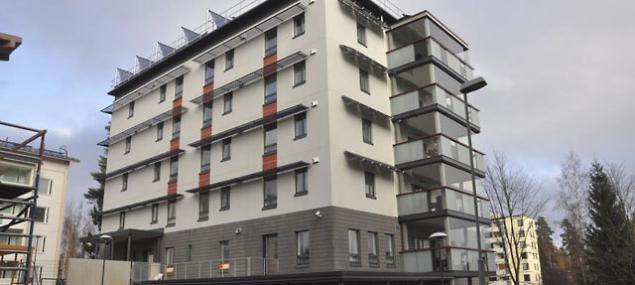643
A house without electricity bills
Imagine a future without electricity bills. The house is fully self-sufficient in energy by using the sun, wind and heat from the earth. And this is possible even in the north of Finland.
Zero energy house, or so-called active house itself produces as much energy as it consumes. Annual energy consumption - a round zero. Depleted summer surplus energy sold to the power grid through which the winter bought the necessary amount of electricity.
Northern climate creates its own problems for the construction of active buildings. The long, dark and cold winters require a well-planned system of energy recovery, thermal insulation equipment and quality waterproofing materials.
In spite of everything, the active construction of houses is possible thanks to new building materials, modern technology and active research work. This question engaged in dozens of universities around the world, including the Finnish Aalto University.
The effectiveness of the proposed solutions is first tested in experimental houses. The first Finnish pilot house called "Luukka '(hatch) was designed by the students of the Faculty of Architecture of Aalto University.

Home - Power
Active House produces the energy it needs via geothermal heat and solar and wind energy. The active home does not necessarily stand out from the other buildings of the street, because all the necessary equipment can be seamlessly integrated into the design.
Design begins with the selection of a suitable place where the house will be built. For example, for the recovery of solar energy should be close to a large number of trees, cast a shadow, and the windows it is best to pay the south.
Power consumption reduced to a minimum
In terms of efficiency, it is important to take care and to minimize energy consumption. This does not mean that the tenant will have to give up the amenities - in the active house to live, as in any other house
. Consumption is reduced by technical solutions. The house is built with thick high thermal insulation. It establishes a powerful ventilation system, which is connected to the system of recycling waste heat. Fresh indoor air, among other things, improves comfort.
House with an extremely simple architectural form is easy to make energy-efficient, for the reason that no unnecessary protrusions to minimize heat loss. Construction of houses active so well with the Finnish functional architectural traditions.
Technology is already applied
In Finland, already active at home - one of them was built in the city of Kuopio, in the central part of the country. The second house is located in Järvenpää, near Helsinki.
House in Kuopio - a student residence with 47 apartments. The use of tenants includes a gym, as well as steam and infrared sauna. The house itself produces energy consumption by using solar panels and geothermal heating systems.
Active multi-storey building built in Järvenpää in summer 2011. In its 44 apartments for the elderly. The house operates a geothermal heating system. Solar, in turn, heat the water and electricity supply house. Even the elevators braking energy is used to generate electricity.
The ventilation system collects almost 80% of the thermal energy for heating the secondary. According to calculations made, the house in Järvenpää even produces more energy than it consumes. Thus, it is, apparently, the first in Finland active home with positive energy. Today the company. Build a house in Järvenpää. He is proud of his work: a few years of operation proved that the technology is effective
. In Finland, already it is possible to order a private construction activities at home. Even at the housing fair in Tampere in summer 2012 was a model of the active house, ready for general sale. The house, called "Lantto" (coin), constructed on the basis of operating experience at home "Luukka" Aalto University.
Common goals require
Energy consumption for housing is about 40% of the EU's energy needs. This means that the country could stop climate change through the effective use of active homes.
In May 2010, it adopted a directive on energy-efficient construction, according to which EU countries undertake to fulfill the minimum requirements for the construction of active buildings by 2020.
Zero energy house, or so-called active house itself produces as much energy as it consumes. Annual energy consumption - a round zero. Depleted summer surplus energy sold to the power grid through which the winter bought the necessary amount of electricity.
Northern climate creates its own problems for the construction of active buildings. The long, dark and cold winters require a well-planned system of energy recovery, thermal insulation equipment and quality waterproofing materials.
In spite of everything, the active construction of houses is possible thanks to new building materials, modern technology and active research work. This question engaged in dozens of universities around the world, including the Finnish Aalto University.
The effectiveness of the proposed solutions is first tested in experimental houses. The first Finnish pilot house called "Luukka '(hatch) was designed by the students of the Faculty of Architecture of Aalto University.

Home - Power
Active House produces the energy it needs via geothermal heat and solar and wind energy. The active home does not necessarily stand out from the other buildings of the street, because all the necessary equipment can be seamlessly integrated into the design.
Design begins with the selection of a suitable place where the house will be built. For example, for the recovery of solar energy should be close to a large number of trees, cast a shadow, and the windows it is best to pay the south.
Power consumption reduced to a minimum
In terms of efficiency, it is important to take care and to minimize energy consumption. This does not mean that the tenant will have to give up the amenities - in the active house to live, as in any other house
. Consumption is reduced by technical solutions. The house is built with thick high thermal insulation. It establishes a powerful ventilation system, which is connected to the system of recycling waste heat. Fresh indoor air, among other things, improves comfort.
House with an extremely simple architectural form is easy to make energy-efficient, for the reason that no unnecessary protrusions to minimize heat loss. Construction of houses active so well with the Finnish functional architectural traditions.
Technology is already applied
In Finland, already active at home - one of them was built in the city of Kuopio, in the central part of the country. The second house is located in Järvenpää, near Helsinki.
House in Kuopio - a student residence with 47 apartments. The use of tenants includes a gym, as well as steam and infrared sauna. The house itself produces energy consumption by using solar panels and geothermal heating systems.
Active multi-storey building built in Järvenpää in summer 2011. In its 44 apartments for the elderly. The house operates a geothermal heating system. Solar, in turn, heat the water and electricity supply house. Even the elevators braking energy is used to generate electricity.
The ventilation system collects almost 80% of the thermal energy for heating the secondary. According to calculations made, the house in Järvenpää even produces more energy than it consumes. Thus, it is, apparently, the first in Finland active home with positive energy. Today the company. Build a house in Järvenpää. He is proud of his work: a few years of operation proved that the technology is effective
. In Finland, already it is possible to order a private construction activities at home. Even at the housing fair in Tampere in summer 2012 was a model of the active house, ready for general sale. The house, called "Lantto" (coin), constructed on the basis of operating experience at home "Luukka" Aalto University.
Common goals require
Energy consumption for housing is about 40% of the EU's energy needs. This means that the country could stop climate change through the effective use of active homes.
In May 2010, it adopted a directive on energy-efficient construction, according to which EU countries undertake to fulfill the minimum requirements for the construction of active buildings by 2020.
























